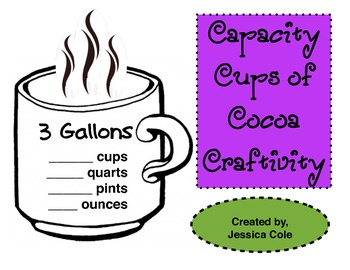CAPACITY Cups of Cocoa Craftivity (CCSS Aligned)
Jessica Cole - Resources to Educate
870 Followers
Grade Levels
3rd - 5th, Homeschool
Subjects
Resource Type
Standards
CCSS3.MD.A.2
CCSS4.MD.A.1
CCSS4.MD.A.2
CCSS5.MD.A.1
CCSS5.MD.B.2
Formats Included
- PDF
Pages
21 pages
Jessica Cole - Resources to Educate
870 Followers
Description
What better way to reinforce a concept than with a craftivity!! Students build their own cup of hot cocoa using capacity equivalencies.
16 Different Capacity Cups Included. Students have to determine the ounces, pints, quarts, gallons, and cups for a given capacity. As a bonus, I have included my Capacity Equivalent Strips which are available for separate purchase.
Easy to follow printable directions for each student is included. Step by step directions tell students when to cut, color, and glue.
Simple independent activity that can be differentiated as capacities are tiered to allow for each student to be successful.
Warm up this winter with capacity!!
16 Different Capacity Cups Included. Students have to determine the ounces, pints, quarts, gallons, and cups for a given capacity. As a bonus, I have included my Capacity Equivalent Strips which are available for separate purchase.
Easy to follow printable directions for each student is included. Step by step directions tell students when to cut, color, and glue.
Simple independent activity that can be differentiated as capacities are tiered to allow for each student to be successful.
Warm up this winter with capacity!!
Total Pages
21 pages
Answer Key
N/A
Teaching Duration
40 minutes
Report this resource to TPT
Reported resources will be reviewed by our team. Report this resource to let us know if this resource violates TPT’s content guidelines.
Standards
to see state-specific standards (only available in the US).
CCSS3.MD.A.2
Measure and estimate liquid volumes and masses of objects using standard units of grams (g), kilograms (kg), and liters (l). Add, subtract, multiply, or divide to solve one-step word problems involving masses or volumes that are given in the same units, e.g., by using drawings (such as a beaker with a measurement scale) to represent the problem.
CCSS4.MD.A.1
Know relative sizes of measurement units within one system of units including km, m, cm; kg, g; lb, oz.; l, ml; hr, min, sec. Within a single system of measurement, express measurements in a larger unit in terms of a smaller unit. Record measurement equivalents in a two-column table. For example, know that 1 ft is 12 times as long as 1 in. Express the length of a 4 ft snake as 48 in. Generate a conversion table for feet and inches listing the number pairs (1, 12), (2, 24), (3, 36),...
CCSS4.MD.A.2
Use the four operations to solve word problems involving distances, intervals of time, liquid volumes, masses of objects, and money, including problems involving simple fractions or decimals, and problems that require expressing measurements given in a larger unit in terms of a smaller unit. Represent measurement quantities using diagrams such as number line diagrams that feature a measurement scale.
CCSS5.MD.A.1
Convert among different-sized standard measurement units within a given measurement system (e.g., convert 5 cm to 0.05 m), and use these conversions in solving multi-step, real world problems.
CCSS5.MD.B.2
Make a line plot to display a data set of measurements in fractions of a unit (1/2, 1/4, 1/8). Use operations on fractions for this grade to solve problems involving information presented in line plots. For example, given different measurements of liquid in identical beakers, find the amount of liquid each beaker would contain if the total amount in all the beakers were redistributed equally.





